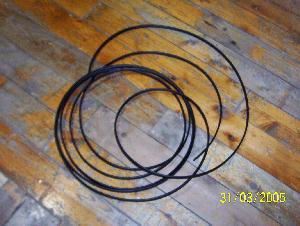
*Simple & Cheap HF Antenna*
Who says ham radio is expensive?
A friend of mine built his version of the G5RV HF dipole to replace another antenna. He says it works great and tunes up good on 10-80 meters. Thatís 3-29 MHz. I figured that I should have one too so he showed me how he built his. He also hooked me up with a couple of plastic insulators for the ends of the wires.
I had an SO-239 connector and about 60í of 12 gauge stranded wire. Canít find the rest of it so I had to buy another 51 feet for $7.14 and I picked up 20í of 300 ohm twin lead (TV) coax for $4.00. Total investment in this antenna is under $12.00.

300- ohm twin lead
Ok, first I soldered the SO-239 connector to the twin lead. I cut the wire leading to the center pin a little short so that the wire would come straight off the connector and not be crooked. After the connector cooled, I whopped the silicone to it. This will prevent water intrusion, which cause shorts and corrosion.
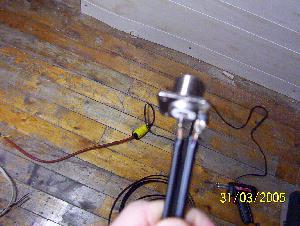
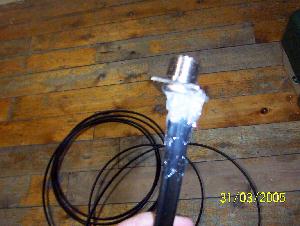
The only soldering gun I own at the moment is 140 watts, it donít heat the chassis of the connector enough to melt solder. It works fine for the center pin. I started by soldering a ring connector on to the wire and then let it cool. Then I used a clamp to hold the ring connector to the 239 chassis. Then carefully using a propane torch, I heated that corner (aiming the flame AWAY from the connector). I used .032" diameter solder so a lot of heat wasnít required. The solder flowed just fine and after it was cool, then I whopped on the silicone.
For durability purposes the SO-239 is mounted to a block of wood and the twin lead is secured.
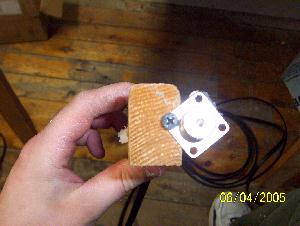
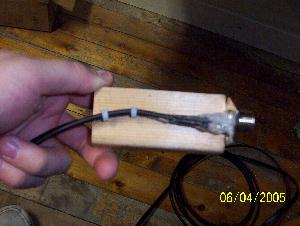
Ok, letís go 20 feet up the line.
To support the center of the antenna I used a short piece of ĺ" plastic PVC pipe that was lying around. Note the screw sticking out of it. I drilled a hole just big enough to fit a piece of 12 gauge through. The hole is angled so that the wires pull in to the angle which means more resistance which means less chance of the wires pulling through and winding up with a broken antenna.
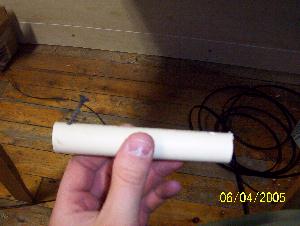
To support the twin lead, I wrapped it over top of the pipe and then zip tied it to itself. From there, the twin lead was connected to the 12 gauge.
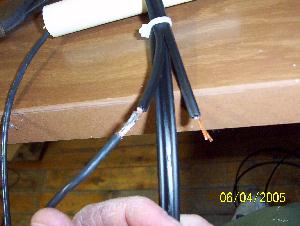
Soldered together
I didnít have big enough heat shrink so I siliconed the connection and then wrapped it with electrical tape. Hereís how it looks once completed. Rather simple concept. See how the holes work for the 12 gauge? A small zip tie is also installed on the inside of the holes to also help prevent the wire from slipping through.
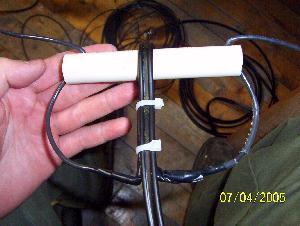
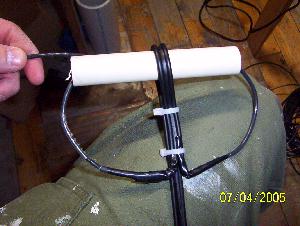
The ends terminate with those plastic insulators. The tip of the wire was hit with silicone to prevent water intrusion.
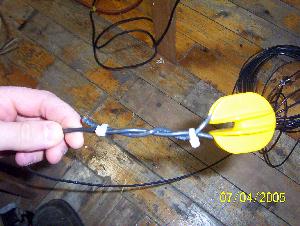
Now letís go put this thing up!!
My bud came down and we put it up. Only got it up about 15í, figured there was no sense getting fancy until it we knew it worked.
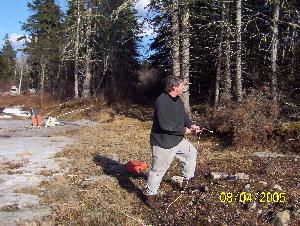
Getting ready to throw a rope up a tree
We hooked up the coax (100í of RG-8) and tried the radio. Tuned up great on 80 meters. I was talking Ĺ way down state crystal clear.
Just had a few minutes and was on 20 meters, worked a guy in Minnesota w/o a problem.
My average reflected power is under 5 watts. 3-4 watts out of 100 FWD isnít too bad. Looks like this antenna is going to work just fine. One of these nights this week, Iíll go out and get it up another 20í.
73ís
Jaden
www.alpharubicon.com
All materials at this site not otherwise credited are Copyright © 1996 - 2005 Trip Williams. All rights reserved. May be reproduced for personal use only. Use of any material contained herein is subject to stated terms or written permission.